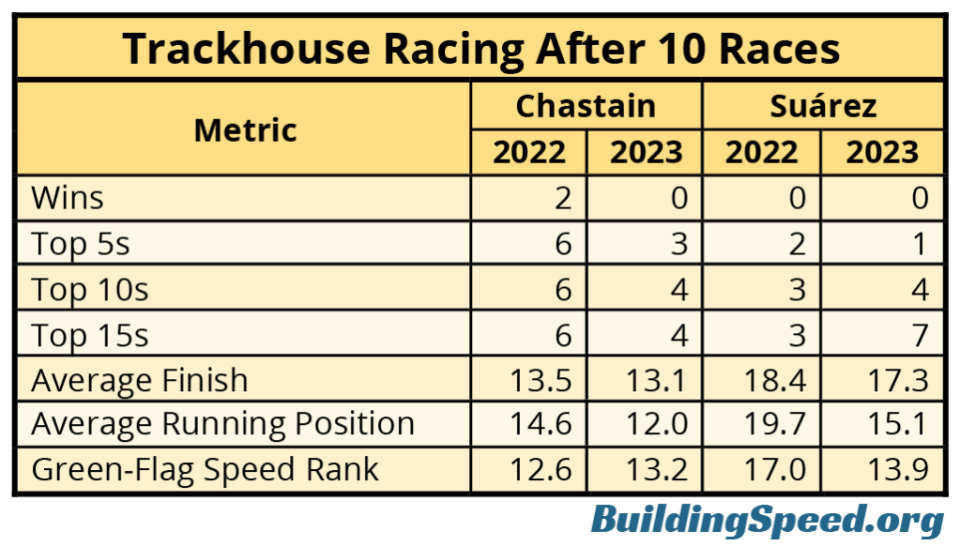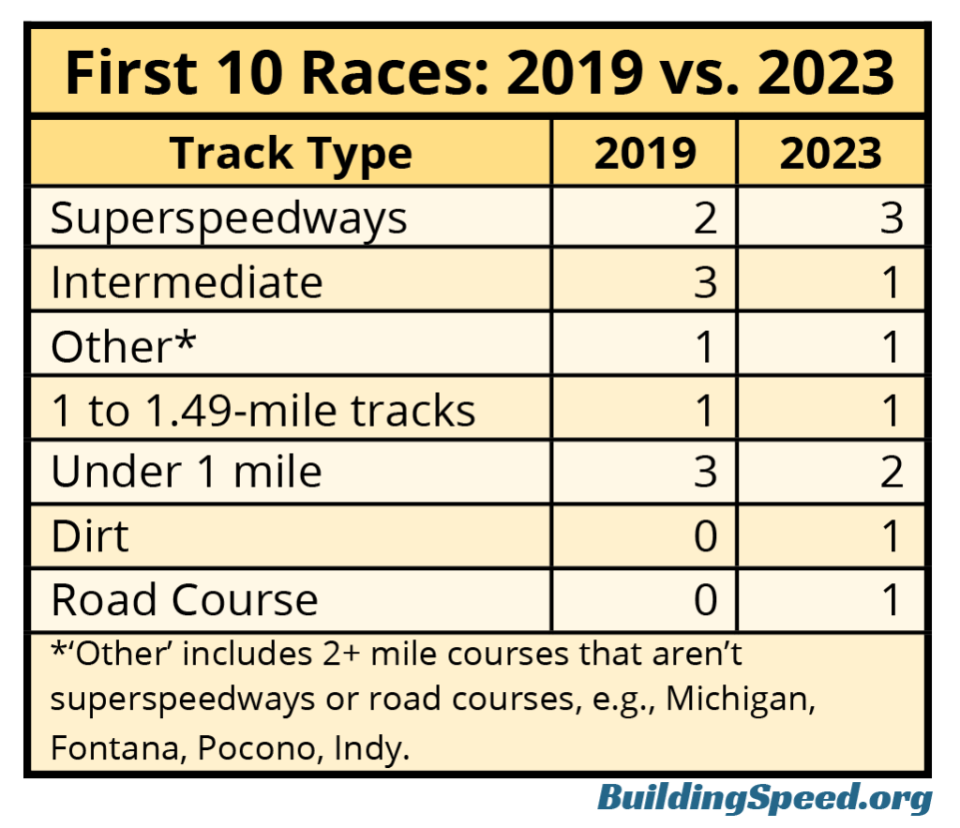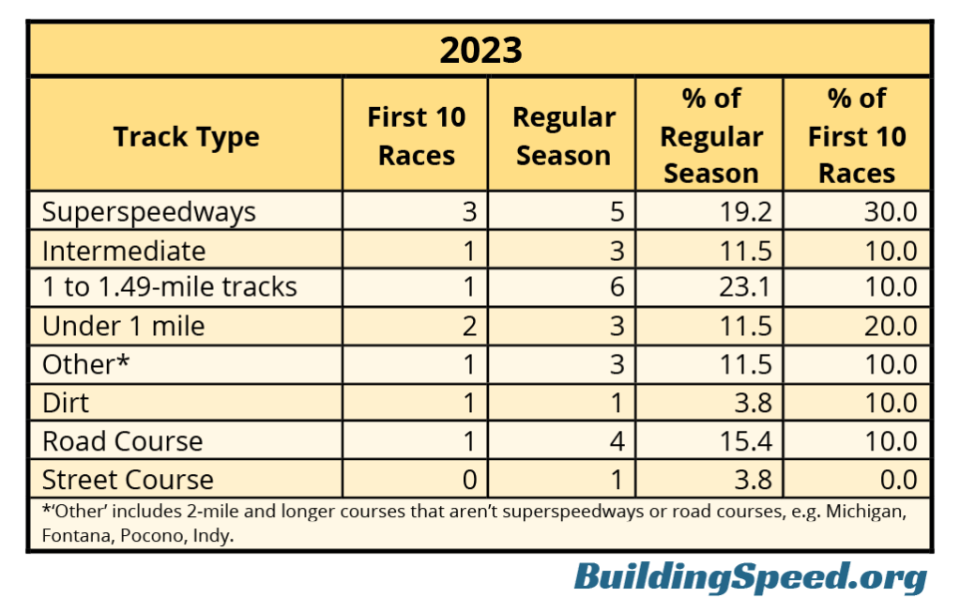Dr. Diandra: Don’t dismiss Trackhouse Racing — or anyone else — after only 10 races
It might be tempting to dismiss Trackhouse Racing as a 2023 contender given the team’s lack of wins and top-five finishes compared to last year. I want to convince you not to give up on them.
Or Kevin Harvick, Tyler Reddick, Denny Hamlin, Bubba Wallace … or any of the drivers who haven’t won yet this year.
Trackhouse was the talk of the garage in 2022 when drivers Ross Chastain and Daniel Suárez each earned their first career wins. Chastain’s Hail Melon move at Martinsville powered him into the Championship 4.
Sure, Chastain is high in the points standings. But, as Martin Truex Jr. will tell you, this championship format demands wins. Trackhouse has no wins through 10 races; last year it had two. Chastain and Suárez each have half the top-five finishes as last year.
But many of their performance metrics are similar to or better than 2022, as I show in the table below.
Both drivers have better running and finishing averages this year. Suárez has improved his green flag speed significantly.
That the finishes aren’t there is partly due to bad luck and partly due to the schedule.
Blame the schedule?
Five years ago, I wouldn’t even try to project anything about the rest of the season until after the first eight to 10 races. Ten races — almost 40% of the regular season — provided enough data to make predictions.
But the schedule was significantly different then.
The 2019 schedule, for example, featured five types of tracks in the first 10 races. All were ovals. Compare that with this year’s first 10 races, as I’ve done in the table below.
This year drivers raced seven different types of tracks in the first 10 races. That gives fans a wonderful smorgasbord of competition — and stats people conniption fits.
In 2019, there were multiple events at three of the five track types after the first 10 races. That’s enough data to start building a representative picture of a team and its likely prospects.
This year, we’ve had multiple races at only two of seven track types. Not only is that less data per track type, the track types for which there is multiple data are some of the least run in the rest of the regular season.
The first 10 races are skewed
Let’s ignore the playoffs and focus on the first 26 races of the regular season. The first 10 races are almost 40% of the regular season. But they’re not a representative 40% of the regular season.
The table below shows the number of races at each track type in the first 10 races and in the regular season.
The final two columns show the percentage of total races in the regular season for each track type and the percentage in the first 10 races.
Let’s use superspeedways as an example. The Cup Series runs five races on superspeedways during the regular season. Three of those happen in the first 10 races. The other two take place during the remaining 16 races.
While superspeedways represent 30% of the races run so far, they are less than 20% of all regular season races. That means superspeedways are overrepresented in data we have so far.
So are the shortest tracks. Only one return visit to Richmond remains in the regular schedule. Two-thirds of the short track races in the regular season are complete.
The most extreme example of over representation is Bristol’s dirt race. It currently makes up 10% of each driver’s points. Ultimately, however, it only counts for about 4%.
The 1- to 1.49-mile tracks have the opposite problem: These tracks are almost a quarter of the regular season but are only 10% of the first 10 races. They, along with road courses, are underrepresented.
Skew direction matters
Luck plays a larger role at superspeedways than at other track types. But for an accident, Kyle Busch wouldn’t have won Talladega. Or would have won the Daytona 500.
The Bristol dirt race is also something of a wild card. And it’s not unusual to have unexpected winners at road courses. Together, these three track types make up 50% of the first 10 races.
The current schedule thus provides a greater chance for having a lot of different drivers win in the first 10 races of the season. There’s much less of a chance for one driver to win three races in a row as Harvick did in 2018. The first four races were Daytona, two 1.5-mile tracks and Phoenix.
But the enhanced role luck plays in the current schedule means that some drivers won’t win early. That’s especially true if they have more bad luck than average.
Remember that Suárez didn’t win last year until Sonoma, the 16th race of the season. Reddick’s first win in 2022 was at Road America, the 18th race of season.
And Harvick, despite being in position to win several times earlier in the season, didn’t take home a checkered flag until Michigan. That victory came with just four races left before the end of the regular season.
All drivers would rather win sooner than later. But don’t dismiss Trackhouse Racing — or any of them yet. It’s way too soon.
Read more about NASCAR
NASCAR weekend schedule for Dover Motor Speedway NASCAR adds drivers to ‘greatest’ list for 75th anniversary Alex Bowman fractures vertebra in sprint car crash; out 3-4 weeks
Dr. Diandra: Don’t dismiss Trackhouse Racing — or anyone else — after only 10 races originally appeared on NBCSports.com




